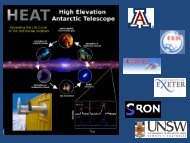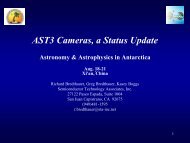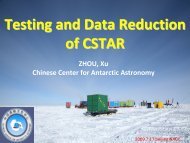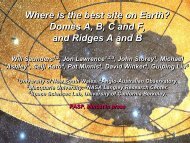Far-Infrared Interferometry for Atomic Fine-Structure Line Observations
Far-Infrared Interferometry for Atomic Fine-Structure Line Observations
Far-Infrared Interferometry for Atomic Fine-Structure Line Observations
Create successful ePaper yourself
Turn your PDF publications into a flip-book with our unique Google optimized e-Paper software.
<strong>Far</strong>-<strong>Infrared</strong> <strong>Interferometry</strong> <strong>for</strong><strong>Atomic</strong> <strong>Fine</strong>-<strong>Structure</strong> <strong>Line</strong><strong>Observations</strong>Hiroshi MatsuoAdvanced Technology Center,National Astronomical Observatory of Japan(ATC/NAOJ)
Contents• Introduction to THz astronomy• AKARI observations• Antarctica Interferometer• Interferometer technologies
Atmospheric Transmission from Atacama(alt. 4800m)1mm 500um 300um 200umMatsushita, Matsuo et al. PASJ (1999)
THz Cosmic Window
Probe of Distant Universe• Hot PlasmaSunyaev-Zel’dovich Effect• Interstellar DUSTSMM observation of ULIRGs• Heavy Elements<strong>Far</strong>-IR atomic lines
Nobeyama Bolometer Array (NOBA)7-element NTD-Ge bolometersλ2 mm (150GHz)Operational since 1992Sunyaev-Zeldovich effectobserved with NOBA(Komatsu et al. 2001)
AzTEC-on-ASTEsurveys of SMGs
AzTEC/ASTE 1100um map of ADF-S (SEP)Hatsukade et al. (2010)1σ < 0.8 mJy (970 arcmin 2 )1σ < 0.6 mJy1σ < 0.8 mJy (970 arcmin 2 )0.5 deg• 0.25 deg2 surveyed• About 200 identified sources• Only 11 AKARI sources• z > 1.5
• OIFIR atomic fine structure lines– 63.185mm 4.745THz 5.0×10 5 cm -3– 145.54mm 2.060THz 1.5×10 5 cm -3• OIII 35.1eV– 51.815mm 5.786THz 3.4×10 3 cm -3– 88.356mm 3.393THz 5.0×10 2 cm -3• NII 14.5eV– 121.80mm 2.461THz 2.8×10 2 cm -3– 205.30mm 1.460THz 4.5×10 1 cm -3• NIII 29.6eV– 57.330mm 5.229THz 3×10 3 cm -3• CII 11.3eV– 157.68mm 1.901THz 2.7×10 3 cm -3
Critical Density(cm -3 )[CII][NII][OIII] Ionization PotentialHIIHIPDRG J Stacey 1989Ionization potential(eV)
FIR SED ofStarburst galaxiesOI, OIIINII, NIIICIIFischer et al. (1999)
AKARI <strong>Infrared</strong>Astronomical Satellite◆ 68.5cm telescope apertureLHe and 20K mechanical cooler◆ Instruments<strong>Far</strong>-<strong>Infrared</strong> Surveyor(FIS) 50~180mm<strong>Infrared</strong> Camera(IRC) 2~26mm◆ All sky survey in 6 bands and pointedobservations <strong>for</strong> imaging and spectroscopy◆Sun-synchronous Polar Orbit altitude 700km◆Length 3.7m, Weight 952kg◆2006 Feb.-2007 Aug. (LHe cooled)AKARI project is supported by the following institutes:Nagoya University, University of Tokyo, National Astronomical Observatory ofJapan, National Institute of In<strong>for</strong>mation and Communications Technology,European Space Agency, Imperial College London, University of Sussex,The Open University, University of Groningen/SRON, Seoul National University13
The star <strong>for</strong>mingregion IC1396 by theIRCAKARI All-Sky Survey at 9 µ mThe star <strong>for</strong>mingregion IC4954/4955by the IRCNeighboring Galaxythe Magellanic Cloudby the FISThe Orion region bythe FISThe Cygnus-sX regionby the FIS
<strong>Far</strong>-<strong>Infrared</strong> Surveyor (FIS)Martin-Puplett typeFourier Trans<strong>for</strong>m SpectrometerWavelength coverage60–110um (WIDE-S)110–180um (WIDE-L)Resolution0.36cm -1
The Carina NebulaA very massive star-<strong>for</strong>ming environment at 2.3 kpcfrom N. Smith 24’x12’ = 2 pointings of SFC = 48 ACS pointings
ISO and AKARI observing points
Carina Nebula by ISO LWS[CII]Mizutani, Onaka, Shibai. (2002)
[C II] 158mm & HaN. Smith 2002
[O III] 88mm & Ha
[OIII] Ionization Sources[OIII] 88mm isabout 10 timesstronger than[NII] 122mm or[CII] 158mm allover the regionηCarKeyholeO 型 星N. Smith et al 2004
30Dor region andR136Figure is deleted.[OIII] distributed 150 pc around R136[OIII] 88mm isobserved widelydistributed aroundR136Contour: MIPS 24mmred: O and WR starsKawada et a. (2010)
[OIII] as a probe of highly ionized gasHigh-mass star-<strong>for</strong>ming regionProbe of FUV radiation and electron densityDetailed observation of nearby galaxiesInitial burst of star-<strong>for</strong>mationALMA will observe [OIII] in z > 6 universeGamma-ray burst and star-<strong>for</strong>ming galaxies at z > 8Observe the site of cosmic re-ionizationLet’s start with the Antarctica THz Interferometer !
Antarctic TerahertzInterferometer
Transmittance1Dome_A_winter_75um0.80.6[NII] 122um[OI] 145um[CII] 158um[NII] 205um[OIII] 88um[OI] 63um[NIII] 57um[OIII] 52um0.40.200 1000 2000 3000 4000 5000 6000 7000 8000Frequency [GHz]
FIR atomic fine structure lines• OIgood median– 63.185mm 4.745THz × 0% 0%– 145.54mm 2.060THz △ 4% 0%• OIII– 51.815mm 5.786THz ○ 15% 1.5%– 88.356mm 3.393THz ○ 12% 1.5%• NII– 121.80mm 2.461THz × 0% 0%– 205.30mm 1.460THz ○ 35% 15%• NIII– 57.330mm 5.229THz △ 2% 0%• CII– 157.68mm 1.901THz △ 3% 0%
Antarctic THz Interferometer• Higher angular resolution that HSO 3.5 m aperture• Specifications– Aperture Diameter > 1m– Base <strong>Line</strong> > 10m– Wavelength Coverage 10 mm - 200 mm– Wide FOV with Focal Plane Arrays• Target of Observation– Detailed study of high mass star-<strong>for</strong>ming region– FIR spectroscopic observation of nearby galaxies– Dust and gas in SMM galaxies– MIR-FIR observation of proto-planetary disk– MIR search of exo-planets
NEFD [Jy sqrt s]Comparison of Sensitivitydirect (red) vs. heterodyne (blue)Observing sensitivity from Dome_A_winter_75umD=1m B=10GHz10 2 0 1000 2000 3000 4000 5000 6000 7000 800010 110 010 -1Frequency [GHz]
Direct detector vs. HeterodyneDirect detectors HeterodyneAperture diameter 1 m 1 mElement number 2 10Baseline 50 m 50 mWavelength 200 mm 200 mmNEP/h or T sys 10 -15 W/Hz 0.5 500 KBandwidth 10 GHz 10 GHzFocal plane array 1000 1Synthesized beam 1 " 1 "Field of view 0.25 deg 2 0.5 arcmin 2NEFD 20 mJy (1s, 12h) 10 mJy (1s, 12h)
FTS measurement ofatmospheric transmission• Martin-Puplett type interferometer– InSb bolometer– 100 – 1600 GHz (3mm – 190μm)
MuFT andHeliostatin Nobeyama2005
MuFT image of the sunA. baselines sampledB. synthesized beamC. simulated imageD. observed imageOhta et al.IRMMW-THz2007
Subtraction of two output portsgives cross correlated interferogramLow frequency noise isreduced appreciablyOhta et al. IRMMW-THz2007Luo Yuan, Master’s thesis Tohoku U. 2007
Space THz InterferometerThe Road MapSPECSAKARISpitzerHerschelSPICASPIRITMillimetronFIRIESPRIT
Summary• Probe of distant universe• AKARI observation of ηCarinae• [OIII] observations of highly ionized gas• Interferometer Technology• Antarctica Interferometer






